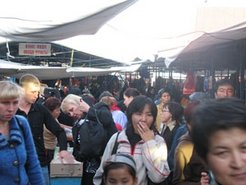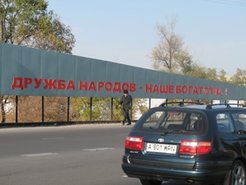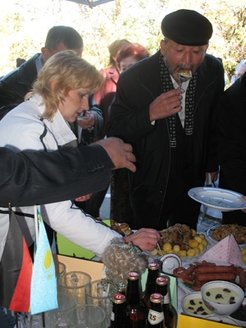Identity and integration of Germans in Kazakhstan

According to official statistics, Kazakhstan is today home to more than one hundred different ethnic groups. Germans whose ancestors had mostly come to Russia over 200 years ago were deported to Central Asia and Siberia during World War II. Later on, Gorbachev’s policies of glasnost as well as Germany’s ethnically defined immigration policies offered them the option to migrate to Germany. Today, less than one fourth of what were once one million Germans remain in Kazakhstan.
This project deals with identity of Germans in Kazakhstan against the backdrop of extensive change. The Kazakh nation-building process, Germany’s modified immigration policies, the out-migration of most Kazakhstani Germans to Germany, and new transnational social networks require readjusted strategies and open up new opportunities. In order to grasp the multiplicity of aspects the study focuses on one field site in Kazakhstan. Between October 2006 and October 2007, I conducted field research in the City of Taldykorgan, which is situated 300 km northeast of Almaty. The city has about 130 000 inhabitants and the German population is stated to be about 1 500.
Integration in Kazakhstan
After the collapse of the Soviet Union in 1991, Kazakhstan was formed as a nation-state based on the model of the former Soviet republic. The nation-building process was not only in this respect tied to the Soviet past. Of particular importance for this research is the significant relevance of ethnic nationality during the Soviet period (Brubaker 1999). My research explores in how far the Germans perceive and represent themselves as a differing nationality or ethnic minority in present day Kazakhstan, and how they are integrated into the Kazakh nation both legally and in official discourse.

Many authors (e.g. Holm-Hansen 1999; Diener 2004; Cummings 2006) underline that ethnic identity has gained increasing importance over the course of the Kazakh nation-building process. The implications for the German minority are twofold: on the one hand, this model of nation-building gives them the opportunity to ‘reinvent’ their traditions and to revitalise the German language; on the other hand, it should be considered that these policies of ‘ethnification’ weaken the Russophone community in Kazakhstan to which the German minority belongs.
German Identities in Kazakhstan
The process of identity formation is also shaped by two other factors: the work of local institutions and social networks. The situation of the German minority has been deeply affected by the out-migration of the vast majority of Kazakhstani Germans to Germany. Those who stayed behind express feelings of abandonment, but at the same time they do profit from their relations to relatives and friends in Germany. The fact, that the vast majority of Kazakhstani Germans emigrated, allowed not only for the establishment of transnational networks but also implies changing local networks for those who remained in Kazakhstan.

Moreover, the work of German institutions and their impact on the local level has to be considered. In 1989, political activists founded the organisation Wiedergeburt (ger. “rebirth”) as an institution for the German minority in the Soviet Union. Today, the main activities of Wiedergeburt in Kazakhstan are directed towards the maintenance and development of the German minority. German language courses play a crucial role in this.
The above-mentioned aspects regarding state policies, social networks and activities of local institutions all pertain to the process of negotiating identities in day-to-day life. How people identify themselves in relation to others is furthermore constrained by emotional attachments to certain identities as a result of socialisation and life experience. Furthermore, postulated identities must – at least to a certain extent – fit into the prevailing categorisations in order to be able to represent them plausibly.
The following questions are at the core of my research:
- When, how and why do people identify themselves as German? What does ‘Germanness’ mean, and how is it perceived by others?
- How do Kazakhs, Russians, Germans and others live together? When and how do they distinguish themselves from one another?
- What kind of other categories beyond ethnicity are there and when are they used?
References
Brown, Andrew J. 2005. The Germans of Germany and the Germans of Kazakhstan: A Eurasian Volk in the Twilight of Diaspora. Europe-Asia Studies, Vol. 57, No. 4, June 2005, pp. 625-634.
Brubaker, Rogers. 1999. Nationalism Reframed. Nationhood and the national question in the New Europe. Cambridge University Press.
Cummings, Sally N. 2006. Legitimation and Identification in Kazakhstan. Nationalism and Ethnic Politics, 12, 2006, pp. 177-204.
Diener, Alexander C. 2004. Homeland conceptions and ethnic integration among Kazakhstan’s Germans and Koreans. New York (et al.). The Edwin Mellen Press.
Holm-Hansen, Jorn. 1999. Political Integration in Kazakhstan. In: Kolsto, Pal (ed.). Nation-Building and Ethnic Integration in Post-Soviet Societies. An Investigation of Latvia and Kazakhstan. Boulder: Westview Press, pp. 153-226.


